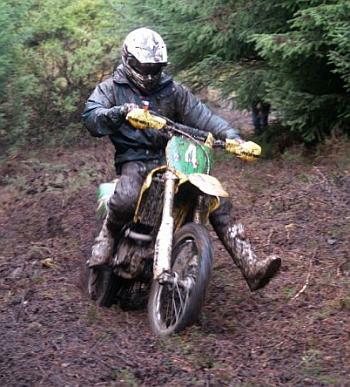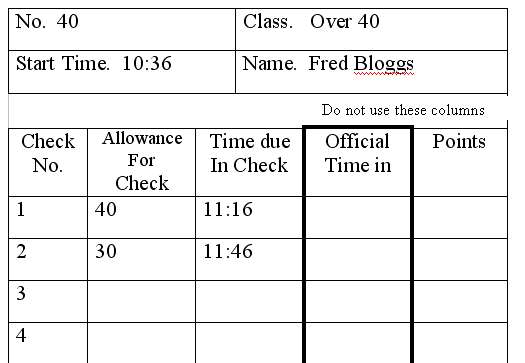Enduro Technique - How to ride off road
![]()
Cambers The way to ride a camber is to be as smooth as possible with any movement and your throttle control. That is not to say you must ride them very slowly. When approaching a camber try to stay as high as possible and out of the brown line. If you slide a little you have the option to go down. Stand up in the middle of the bike and weight the outside footpeg. If it is very tricky or you loose gnip and you must put a foot down, keep most of your weight on the outside peg and not on the seat. Ruts Riding ruts takes a lot of practice and good balance. It is easier, faster and uses much less energy riding a rut standing up with both feet on the pegs. You must focus ahead of you and lean slightly forward on the bike to aid steering and balance. You have to lean left or right to keep the bike upright and to make turns. If you have to sit down when it becomes very tricky, keep your backside as far forward on the scat as possible and avoid your legs constantly running along side the bike, this is the quickest way to get cramp. On some of the very deep ruts you will have to wheelie the bike through to stop it from grounding and getting stuck. Stony Ground and Tree Roots For the smaller stones and tree roots the best way to ride them is to stay loose in a high gear and ignore them. The bike will wiggle around a bit but you will get used to this with experience. For larger stones and roots that you cannot avoid, try and hit them as square as possible keeping the front end light and going at a constant speed. Riding in heather is always a bit daunting especially when there are stones about. You must be in a high gear and stand up in the middle of the bike. Reading the ground is all-important and will take time to learn. Keep to the heather that looks most constant avoiding any lumps or strange areas. This should keep you away from the larger stones and hazards. You will hit smaller stones but with practice over this type of going you will be able to control any kicks or direction changes that the bike will make. To ride in heather is about experience rather than technique. Extreme Sections & Getting Stuck Towards the end of the Enduro the going will tend to get more cut up and difficult to ride especially if it is wet. You are constantly having to sit down and use your legs. In this stage of the Enduro your mental and physical strength comes into play. When you come to extreme sections on the course you have to get through them quickly to avoid getting stuck or using too much energy. Be very aggressive when you need to be but think of where you are going. The aim is to keep going at all cost. If you are finding it hard, it is hard and everyone else will find it hard as well. If you get stuck there are a number of ways to get going again : jump off the bike with the engine still running and in gear and push it out or over the hazard ; if you are totally buried move the bike from side to side and try again to push it out using the engine while lifting under the bars with your left arm; if on a rare occasion when you have to lift the bike out, lift the back out first as the steering head will allow this. Riding the Special Test Riding the test takes total commitment. The test is about 60% ability and 40% mental
commitment. You will have to ride the bike very aggressively, not wildly. The test
requires a different approach than riding the going. When cornering on flat ground sit on the outside of the seat and lean the opposite way from the bike. Keep your inside foot outstretched in front of you while weighting the outside footpeg with the other. Feed in the power slowly and don't open the throttle fully until you can keep it wide open.When in rutted or bermed corners lean with the bike. Again inside foot outstretched in front of you. As you approach the corner ease off the brakes and begin to lean over feed in the power to prevent you from falling right over. Again don't bring on the power completely until you can keep it on. Avoid over use of the clutch when comerig and try to be as smooth but aggressive as possible. When you are on the straights make sure that you have the throttle fully open. Sounds stupid but most riders don't open the throttle fully even when they think the have. FITNESS It is a fact that the fitter you are the easier riding the bike is. To be fit for the bike you need to be physically fit a well as bike fit. Bike fit is when you can ride the bike without obtaining sore muscles after a short time. Physically fit is when you can maintain maximum effort and concentration throughout the day. You should aim to be on your bike for at least 2-3 hours per week. The physical training side is more difficult to achieve and requires a high degree of motivation and commitment. This can consist of a run swim or cycle, 2-3 times per week. MACHINE PREPARATION Controls The position of your brake and clutch levers will depend on your individual riding style and physique. In general most of the top Enduro riders set the position of their controls for when they are standing. This is because when you are travelling cross- country , this is the position when you are in most control. You should also try and ride with only two fingers on the levers and will allow you to retain a good grip on the bars. Wheels To aid tyre changing it is a good idea to do the following. 1. Move the security bolt around to the first set of diverging spokes next to the valve. 2. Throw away the original rim tape; replace with a narrow run of duct tape wrapped round
two to three times. 3. Tyre changing techniques vary from individual to individual. Once you have mastered a technique then it is just down to practice. Always use the best tyres that you can afford. The tyre pressures, unless you are running mooses, are a compromise between preventing punctures and obtaining maximum grip. A guide to tyre pressures: Sand/Mud 10 - 12 PSI Mud/Rock 12 - 13 PSI Rock 13 - 15 PSI If the going is dry rocky and fast then you should run a slightly higher pressure to avoid getting punctures.
Scottish Enduro Training Riding Techniques prepared by Malcom Bissett 2. How to mark up your time card, at sign on and during the event. At signing on for each event you will be given a time card. Usually sealed in a plastic wallet it will have a space for your name, riding number and start time. These items may be filled in for you by the organisers but you will have to fill in the rest yourself. Check the number of laps you have to do and the time allowed for each lap, or in the
case of long laps, the time between checks.
Above is your card at the start of the event with the time you aim to meet. However due to your own speed or errors on the course you may arrive late at a check. If you arrive early you do not check in until your set time (you wil be penalised for early arrival). Once you are late you stay late. Below is a card with actual times on it.
(A) On time - zeroed the check. There are several tricks to be employed with time cards. One is to arrive early at a check and accept the time penalties if you know the next check is tight and it could put you over your hour. Better to have a few extra points than be disqualified on time. The above instructions are basic - and if you know better let me know.
|
![]()
 Downhill - sit back
Downhill - sit back

